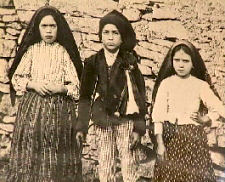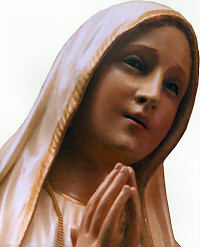Easter: May 13th
Solemnity of the Ascension of Our Lord; Optional Memorial of Our Lady of Fatima
Other Commemorations: Our Lady of the Most Blessed Sacrament (Hist); Julian of Norwich, Religious (Hist)
» Enjoy our Liturgical Seasons series of e-books!
The Blessed Virgin Mary is venerated under this title following apparitions to three shepherd children — Lucia, Jacinta and Francisco — in Portugal in 1917. The message of Fatima includes a call to conversion of heart, repentance from sin and a dedication to the Blessed Virgin Mary, especially through praying the Rosary. This optional memorial is new to the USA liturgical calendar and is inscribed on May 13.
The ecclesiastical provinces of Boston, Hartford, New York, Newark, Philadelphia, and Omaha have retained the celebration of the Ascension of the Lord on the proper Thursday, while all other provinces have transferred this solemnity to the Seventh Sunday of Easter.
According to the 1962 Missal of Bl. John XXIII the Extraordinary Form of the Roman Rite, today is the feast of St. Robert Bellarmine. He was famous throughout Europe as a theologian, and as a strenuous defender of the Faith in controversy with Protestants. He joined the Society of Jesus, and was later made Cardinal and Archbishop of Capua. His numerous writings include works of devotion and instruction, as well as of controversy. He died in 1621, and was canonized and declared Doctor of the Church in 1931. His feast in the Ordinary Form of the Roman Rite is celebrated on September 17.
Today is also the feast of Our Lady of the Most Blessed Sacrament. This title was given to our Blessed Mother in May 1868 by Saint Peter Julian Eymard to honor her relationship to the Holy Eucharist and to place her before us as a model in our duties and devotion to the Blessed Sacrament.
Our Lady of Fatima
 The famous apparitions of the Virgin Mary to the children of Fatima took place during the First World War, in the summer of 1917. The inhabitants of this tiny village in the diocese of Leiria (Portugal) were mostly poor people, many of them small farmers who went out by day to tend their fields and animals. Children traditionally were assigned the task of herding the sheep.
The famous apparitions of the Virgin Mary to the children of Fatima took place during the First World War, in the summer of 1917. The inhabitants of this tiny village in the diocese of Leiria (Portugal) were mostly poor people, many of them small farmers who went out by day to tend their fields and animals. Children traditionally were assigned the task of herding the sheep.
The three children who received the apparitions had been brought up in an atmosphere of genuine piety: Lucia dos Santos (ten years old) and her two younger cousins, Francisco and Jacinta. Together they tended the sheep and, with Lucy in charge, would often pray the Rosary kneeling in the open. In the summer of 1916 an Angel appeared to them several times and taught them a prayer to the Blessed Trinity.
On Sunday, May 13, 1917, toward noon, a flash of lightning drew the attention of the children, and they saw a brilliant figure appearing over the trees of the Cova da Iria. The "Lady" asked them to pray for the conversion of sinners and an end to the war, and to come back every month, on the 13th.
Further apparitions took place on June 13 and July 13. On August 13 the children were prevented by local authorities from going to the Cova da Iria, but they saw the apparition on the 19th. On September 13 the Lady requested recitation of the Rosary for an end to the war. Finally, on October 13, the "Lady" identified herself as "Our Lady of the Rosary" and again called for prayer and penitence.
On that day a celestial phenomenon also took place: the sun seemed to tumble from the sky and crash toward earth. The children had been forewarned of it as early as May 13, the first apparition. The large crowd (estimated at 30,000 by reporters) that had gathered around the children saw the phenomenon and came away astounded.
Official recognition of the "visions" which the children had at the Cova da Iria came on October 13, 1930, when the bishop of Leiria - after long inquiry - authorized the cult of Our Lady of the Rosary at the site. The two younger children had died: Francisco (who saw the apparition but did not hear the words) on April 4, 1919, and his sister Jacinta on February 20, 1920. Sister Lucia died on February 13, 2005, at her Carmelite convent in Coimbra, Portugal, after a long illness.
—Excerpted from Dictionary of Mary, Catholic Book Publishing Company
The Message of Fatima
 The public message of Fatima recalls that of Lourdes. Through the children Mary urges prayer for sinners, recitation of the Rosary, and works of penance. On October 13 she said: "I have come to exhort the faithful to change their lives, to avoid grieving Our Lord by sin; to pray the Rosary. I desire in this place a chapel in my honor. If people mend their ways, the war will soon be over."
The public message of Fatima recalls that of Lourdes. Through the children Mary urges prayer for sinners, recitation of the Rosary, and works of penance. On October 13 she said: "I have come to exhort the faithful to change their lives, to avoid grieving Our Lord by sin; to pray the Rosary. I desire in this place a chapel in my honor. If people mend their ways, the war will soon be over."
But Mary also confided several "secrets" to the children, some of which Lucy subsequently transmitted. Presumably there was prediction of another war in the near future and a request for special veneration of the Immaculate Heart of Mary. The final secret Lucia is thought to have entrusted to Pope John XXIII.
As at Lourdes, the "apparitions" of Fatima have brought crowds of visitors. Pilgrimages, which began in the summer of 1917, have experienced growing success, not only among the Portuguese themselves but also among people from other countries, including the United States. The national pilgrimage following ecclesiastical recognition of the apparitions (May 13, 1931) is said to have drawn more than a million participants.
Popes have shown exceptional favor toward Fatima, Pius XII, Paul VI, and John Paul II in particular making a visit to the shrine. The papal interest and the basilica built at the site of the apparitions has helped to swell the summer pilgrimages to Fatima. Crowds comparable to, and sometimes larger than, those at Lourdes are not uncommon. In a rustic setting, pilgrims hear the message repeated that Mary spoke to the children: prayer, works of penance, recourse to her Immaculate Heart.
—Excerpted from Dictionary of Mary, Catholic Book Publishing Company
Patronage: diocese of Leiria–Fátima, Portugal
Highlights and Things to Do:
- Visit Catholic Culture's special section on Our Lady of Fatima.
- For further reading:
- See Catholic Cuisine for food ideas.
- Virtually visit the Shrine of Our Lady of Fatima in Portugal.
Our Lady of the Blessed Sacrament
 This title penetrates the mystery itself of the Eucharist, and when well understood, manifests to us the most important part granted to Mary in the economy of the Holy Eucharist.
This title penetrates the mystery itself of the Eucharist, and when well understood, manifests to us the most important part granted to Mary in the economy of the Holy Eucharist.
If we have thoroughly seized Pierre Eymard's thought we understand that she is, first, the Mother of Jesus, giving to the Word her most pure blood, which was changed on the day of the Incarnation into His own Body, into His own Blood, in order to consecrate it later, on the night of the Last Supper, into His Sacrament of Love.
Our Lady of the Blessed Sacrament is Mary receiving in quality of universal dispensatrix of grace, the full and absolute disposition of the Eucharist and the graces that It contains, because this Sacrament is the most efficacious means of salvation, the fruit par excellence of the Redemption of Jesus Christ. To her, consequently, it belongs to make Jesus in the Sacrament known and loved; to her it belongs to spread the Eucharist throughout the world, to multiply churches, to raise them in infidel lands, and to defend faith in the Eucharist against heretics and the impious; to her it belongs to prepare souls for Communion, to rouse them to make frequent visits to Jesus, and to assist zealously at the Holy Sacrifice of the Mass. She is the treasure-house of all the graces comprised in the Eucharist, both those that prepare the soul for It and those that flow from It.
—Month of Our Lady of the Blessed Sacrament by St. Peter Julian Eymard
Highlights and Things to Do:
- Read the Month of Our Lady of the Blessed Sacrament by Pierre Julian Eymard.
- Pray the novena to Our Lady of the Blessed Sacrament.
Julian of Norwich
 Almost nothing is known of her early life before she became an anchoress. It is unknown if she was from Norwich or chose to move there, and even not verified that her name was Julian before she became an anchoress near the church of Saint Julian. Recluse under the direction of Benedictines in Norwich, England. Mystic, visionary, and writer. Her book, Revelations of Divine Love, which contains sixteen revelations she received while in an ecstatic trance, is still in print. She meditated on, spoke on, and wrote on the power of love of evil, Christ’s Passion, and the nature of the Trinity. In her early 60s she shut herself in complete seclusion at Conisford, Norwich, and never left again.
Almost nothing is known of her early life before she became an anchoress. It is unknown if she was from Norwich or chose to move there, and even not verified that her name was Julian before she became an anchoress near the church of Saint Julian. Recluse under the direction of Benedictines in Norwich, England. Mystic, visionary, and writer. Her book, Revelations of Divine Love, which contains sixteen revelations she received while in an ecstatic trance, is still in print. She meditated on, spoke on, and wrote on the power of love of evil, Christ’s Passion, and the nature of the Trinity. In her early 60s she shut herself in complete seclusion at Conisford, Norwich, and never left again.
Not much is known about her personal life, even if her name was truly Julian. She was born around 1342 and died in 1423, lived as an anchoress near the Church of St. Julian in Norwich, England. Because she was never formally beatified or canonized, she is not included in the Roman Martyrology but popular piety sees her as a holy woman of God, and so often refer to her as Mother, Saint or Blessed Julian.
Highlights and Things to Do:
- Read more about St. Julian:
- See this online source for her writings.






